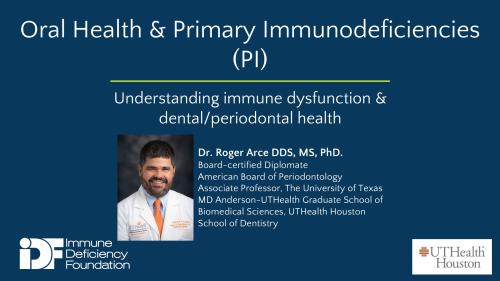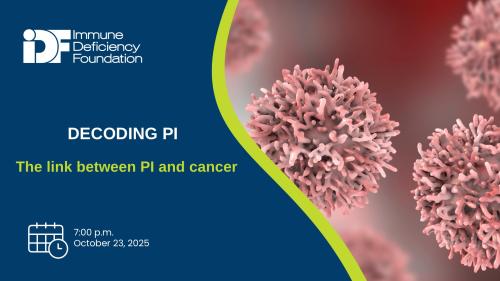
-
Understanding primary immunodeficiency (PI)

Understanding PI
The more you understand about primary immunodeficiency (PI), the better you can live with the disease or support others in your life with PI. Learn more about PI, including the various diagnoses and treatment options.
-
Living with PI
-
Addressing mental health
-
Explaining your diagnosis
- General care
- Get support
- For parents and guardians
-
Managing workplace issues
- Navigating insurance
-
Traveling safely

Living with PI
Living with primary immunodeficiency (PI) can be challenging, but you’re not alone—many people with PI lead full and active lives. With the right support and resources, you can, too.
-
Addressing mental health
-
Get involved

Get involved
Be a hero for those with PI. Change lives by promoting primary immunodeficiency (PI) awareness and taking action in your community through advocacy, donating, volunteering, or fundraising.
-
Advancing research and clinical care
-
Research Grant Program
-
Consulting immunologist
-
Diagnosing PI
-
Getting prior authorization
-
Clinician education
-
Survey research
-
Participating in clinical trials

Advancing research and clinical care
Whether you’re a clinician, researcher, or an individual with primary immunodeficiency (PI), IDF has resources to help you advance the field. Get details on surveys, grants, and clinical trials.
-
Research Grant Program
Hospitalization is an inevitability for babies born with severe combined immunodeficiency, or SCID. It’s imperative that they get treatment to restore their immune system as soon as possible, and that treatment always takes place in the hospital setting. Stays can last for months.
So, how can a parent or caregiver lessen the impact of such a disruptive, stressful, and painful experience? At a June SCID Compass Lunch & Learn entitled, “Supporting Infants’ Developmental Needs in the Hospital,” Kim Ong, child life specialist at the University of California San Francisco Benioff Children’s Hospital, discussed the importance of the parent-child relationship, how facets of hospital life affect infants, and steps parents can take to create a more normal environment for their children.
Infants spend time adapting to their new environment and trying to self-regulate but can’t do that without caregiver support, said Ms. Ong. Caregivers can help a baby shift from sleep to awake, regulate their social behavior, attend to auditory and visual stimuli, and interact with people and their environment.
“If you take anything away from this, it’s that as we strive to understand infants and their needs, we really need to understand and respect that infants, starting from the newborn, are incredibly competent and unique and that their relationship with and reliance on their primary caregiver is so critical to their development,” said Ms. Ong.
“It’s the consistent interactions with the caregiver that are teaching the infant how to deal with distress ultimately. It’s so important to remember that the parent’s role as an attachment is one of the most important aspects in predicting the child’s later social and emotional output.
“The quality of the attachment is really determined by the caregiver’s response, in general, but also when the infant is threatened – physically ill, emotionally upset, scared. Honestly, that is a lot of what we see in the hospital, so it has so much relevance.”
The hospital environment presents adverse experiences for a baby, which can undermine brain development. Cumulative adverse experiences,not buffered by the protection of a trusted caregiver and a safe, stable environment can lead to long-term disruptions in brain development and toxic stress response.
Toxic stress is dangerous, explained Ms. Ong, affecting a baby’s ability to regulate, and causing learning difficulties later in life.
To avoid toxic stress, parents should stay emotionally attuned to their infants and create an environment that is supportive and promotes the infant’s regulation and understanding that the caregiver is avi
“That cannot be underestimated,” said Ms. Ong
Ms. Ong outlined challenges faced in the hospital and provided parents with guidance on coping when faced with these challenges.
Challenge: The hospital is an abnormal environment. The sounds of machines beeping, bright lights, medical procedures being done to the body – all of these can threaten an infant’s sense of self and disrupt their ability to trust their environment.
Solution: Create a developmentally supportive space to promote attachment, motor activity, and trust in the environment.
- Communicate infant needs and preferences to medical teams on All About Me developmental sheets posted outside the room.
- Adjust the environment. If it’s too bright, turn the lights low and put the shades down. If there’s too much auditory stimulation disrupting the infant’s sleep, use a white noise machine.
- Obtain a play mat for out-of-crib experiences.
- Prioritize out-of-crib experiences like holding the baby, tummy time, and rolling.
- During birth to 2 months, interact face-to-face out of the crib. Provide play items like a mobile, pacifier, black and white stimulation toys, books, mirrors, and rattle.
- During 2 to 9 months, engage the baby out of the crib with toys, textured items, books, mirrors, rattles, and comfort items.
- During 9 to 12 months, engage the baby out of the crib with books, mirrors, cause-and-effect toys, textured toys, music toys, instruments, comfort items, and mobility toys. Set up a protective gate around the play area for more gross motor activity.
Challenge: The baby will experience multiple unfamiliar caregivers and inconsistency of routine. This threatens their need for predictability, impacts the bond with the caregiver, and affects the infant’s learning and development.
Solution: Use strategies to lessen the stimuli and create a routine around the baby’s schedule.
- Utilize cluster care. Do a lot of the medical interventions – exams, vitals, procedures – at one time so that the infant is not constantly woken up to do things.
- Inquire about primary nursing where a single nurse is assigned to take care of the infant.
- Communicate the infant’s needs to the medical team, such as sleep schedule, and ask them to adapt their schedule to the baby’s.
- Post the All About Me sheet to list sleep and wake schedule, dictating both medical care and the use of lighting in the room.
- Remain present and consistent for the baby. Learn infant massage for bonding and affirming the attachment.
Challenge: Sensory stimulation, such as the use of a thermometer, a port, a blood pressure cuff, the smell of alcohol, and the noise of machines all add up to stressors for the infant.
Solution: Pay close attention to the infant’s reactions during these times.
- Respond to the cues of the infant like crying, gaze aversion, arching, yawning, grimacing, jerking. Sometimes these are quite subtle but know that infants can easily be over-stimulated and they might show it through a yawn, or averting their gaze.
- Support the infant with self-soothing, or a comfort measure like pressure.
- Perform one medical procedure at a time, and slow them down.
- Avoid screen time completely.
- Consider an infant’s temperament because that can influence what they respond to in terms of stimulation.
Challenge: The baby experiences pain through intrusive medical procedures, such as needles, and because they’re still learning how their own body works and can’t process stimuli from outside of their body, that can alter the development of the brain, behavior, and stress response.
Solution: Use a variety of strategies to mitigate the effects of pain.
- Consult with the medical team about pain experienced by the baby and discuss pharmacological pain management, like numbing cream for needles.
- Utilize an infant pain assessment scale but caregivers should also discern what certain cries, grimaces, or motor movements mean.
- Calm the baby with positive touch, and incorporate familiar supports during painful and stressful experiences.
- Create concrete cues for when a painful experience is about to start and when it ends. For example, to avoid the crib becoming a threatening place, turn on the light when something obtrusive is about to happen or reposition the baby at the end of the crib for procedures so they can anticipate the procedure.
- Refrain from holding down or restraining the infant, and instead hug the infant or sit the infant up for procedures.
- Provide comfort measures like swaddling, a pacifier, soothing music, or sugar water.
- For older infants, distract with music, a cause and effect toy, a light spinner, or a Buzzy which vibrates and blocks the message of pain because they concentrate on the vibration and not the pain.
- If there are multiple injections needed, advocate for the most painful one to be last, wait for the infant to recover in between pokes, and offer breaks.
Finally, parents should tend to their own needs, said Ms. Ong.
“Infants look to the parent to see how they’ll respond to something, especially when it’s a new experience and there is a shared emotion, shared attention. So, if unfamiliar people come in and the infant is looking to the parent and the parent is worried and stressed, that can transmit to the child and teach and condition the infant to respond in the same way. If the parent is calm and verbally reassuring, then that conditions a different kind of response,” she said.
Ways that parents can find support include:
- Access services for the infant like physical therapy, occupational therapy, and music therapy, and child life specialist and social worker support.
- Seek out services like parent liaisons and parent support groups.
- Pre-plan for respite, whether that’s through a family member, a friend, or a nurse.
- Educate yourself on diagnosis, treatment, and care to help you navigate, feel more in control, and advocate for your infant.
- Communicate and partner with the medical team and hospital staff to ensure that the infant’s needs are met.
To view the presentation, click here.
Your Situation
Topics
Diagnosis
Related resources
Sign up for updates from IDF
Receive news and helpful resources to your cell phone or inbox. You can change or cancel your subscription at any time.





The Immune Deficiency Foundation improves the diagnosis, treatment, and quality of life for every person affected by primary immunodeficiency.
We foster a community that is connected, engaged, and empowered through advocacy, education, and research.
Combined Charity Campaign | CFC# 66309




